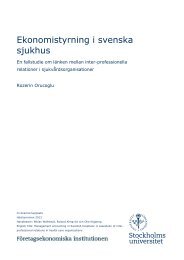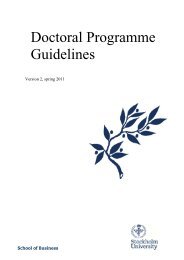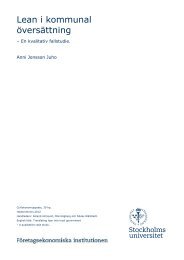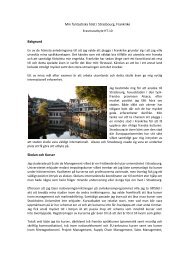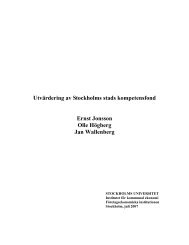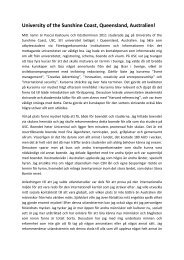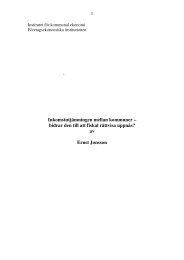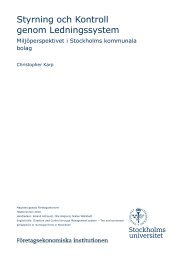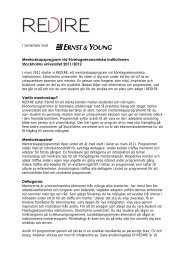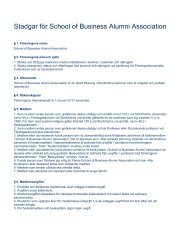Organizational Atmospheres: Foam, Affect and Architecture
Organizational Atmospheres: Foam, Affect and Architecture
Organizational Atmospheres: Foam, Affect and Architecture
Create successful ePaper yourself
Turn your PDF publications into a flip-book with our unique Google optimized e-Paper software.
<strong>Organizational</strong> <strong>Atmospheres</strong><br />
Christian Borch<br />
Deleuze’s case, see Alliez, 2004). However, Sloterdijk’s foam theory has a<br />
much greater emphasis on Tardean imitation dynamics than Deleuze who<br />
is more interested in Tarde’s focus on beliefs <strong>and</strong> desires (Deleuze <strong>and</strong><br />
Guattari, 1987: 219). Although imitation <strong>and</strong> beliefs <strong>and</strong> desires are closely<br />
interrelated in Tarde, this inspirational difference has implications for the<br />
interpretation of organizational behaviour. Thus Deleuze-inspired work is<br />
likely to emphasize desire (Sørensen, 2005), whereas a foam-theoretical<br />
view on organizations has as a major concern the role of imitation. 3<br />
The emphasis on spatiality (<strong>and</strong> thereby the fifth dimension listed above)<br />
is also one of the points where the foam theory differs from, in particular,<br />
Niklas Luhmann’s work. According to Luhmann, social systems, including<br />
organizations, have communicative boundaries rather than spatial bound-<br />
aries (Luhmann, 1997: 76). It is this a-spatial conception of organizations<br />
that Sloterdijk’s foam theory avoids (not least by emphasizing the significance<br />
of atmospheres, thereby attributing greater importance to the environment<br />
than Luhmann does in his systems theory).<br />
Before investigating the spatial aspects of foam, however, I wish to look<br />
closer at the second dimension listed above, the deliberate disregard of the<br />
individual subjects in the organization. This disregard is far from unique to<br />
foam theory. Indeed, it is shared by many post-structualist accounts. This<br />
applies, for instance, to Luhmann’s (2000) systemic sociology of organizations<br />
as well as to Foucauldian studies (e.g. Karlsen <strong>and</strong> Villadsen, 2008;<br />
Munro <strong>and</strong> R<strong>and</strong>all, 2007). The main difference between these approaches<br />
<strong>and</strong> foam theory does not regard the overall ambition of going beyond indi-<br />
vidualistic analyses, but lies rather in how this is done. Whereas both<br />
Luhmann’s systems theory <strong>and</strong> Foucualdian studies are part of the linguistic<br />
turn in social theory, which has emphasized communication <strong>and</strong> discourse<br />
rather than subjectivity, Sloterdijk’s foam theory does not attribute primary<br />
importance to communication but to imitation. As mentioned above, this<br />
move from communication to imitation relates to Sloterdijk’s inspiration<br />
from Tarde. Tarde analyses imitation as a kind of somnambulistic suggestion<br />
<strong>and</strong> thereby points to its hypnotic <strong>and</strong> contagious-affective foundation.<br />
It is this notion of suggestion, or imitation-suggestion, which, I claim,<br />
is key to underst<strong>and</strong>ing foam sociality, <strong>and</strong> hence organizations. 4 One of<br />
the major implications of suggestion is that it undermines the notion of<br />
individuality. The individual <strong>and</strong> his or her desires, inclinations, gestures,<br />
etc., are seen as hypnotically transmitted <strong>and</strong> therefore not specific or characteristic<br />
to the individual in question. Indeed, in Tarde’s sociology, the<br />
individual is nothing but the ‘container’ or agglomeration of various rays of<br />
imitations, some of which may be in conflict with one another. Ruth Leys<br />
has put it this way:<br />
By dissolving the boundaries between self <strong>and</strong> other, the theory of imitationsuggestion<br />
embodied a highly plastic notion of the human subject that radically<br />
called into question the unity <strong>and</strong> identity of the self. Put another way, it made<br />
the notion of individuality itself problematic. (Leys, 1993: 281)<br />
229<br />
Downloaded from<br />
org.sagepub.com at Stockholms Universitet on March 30, 2011



